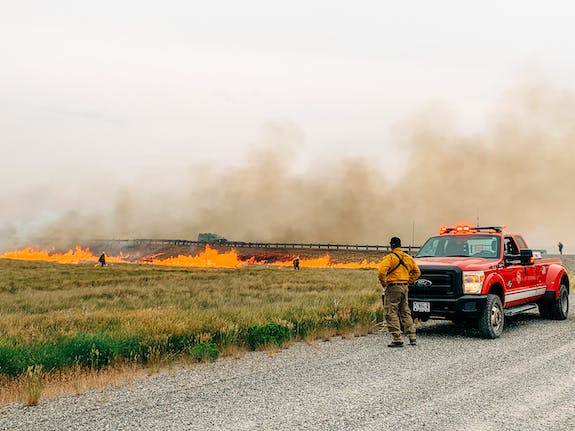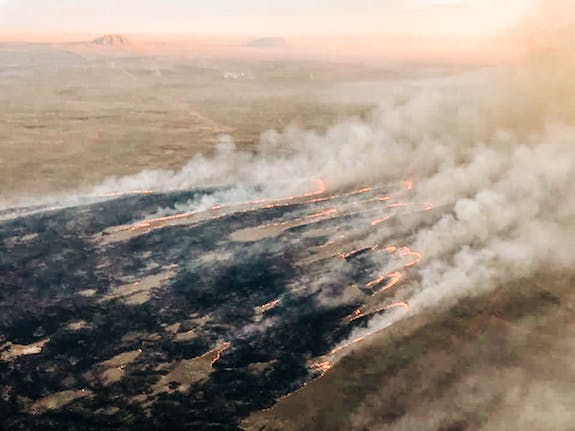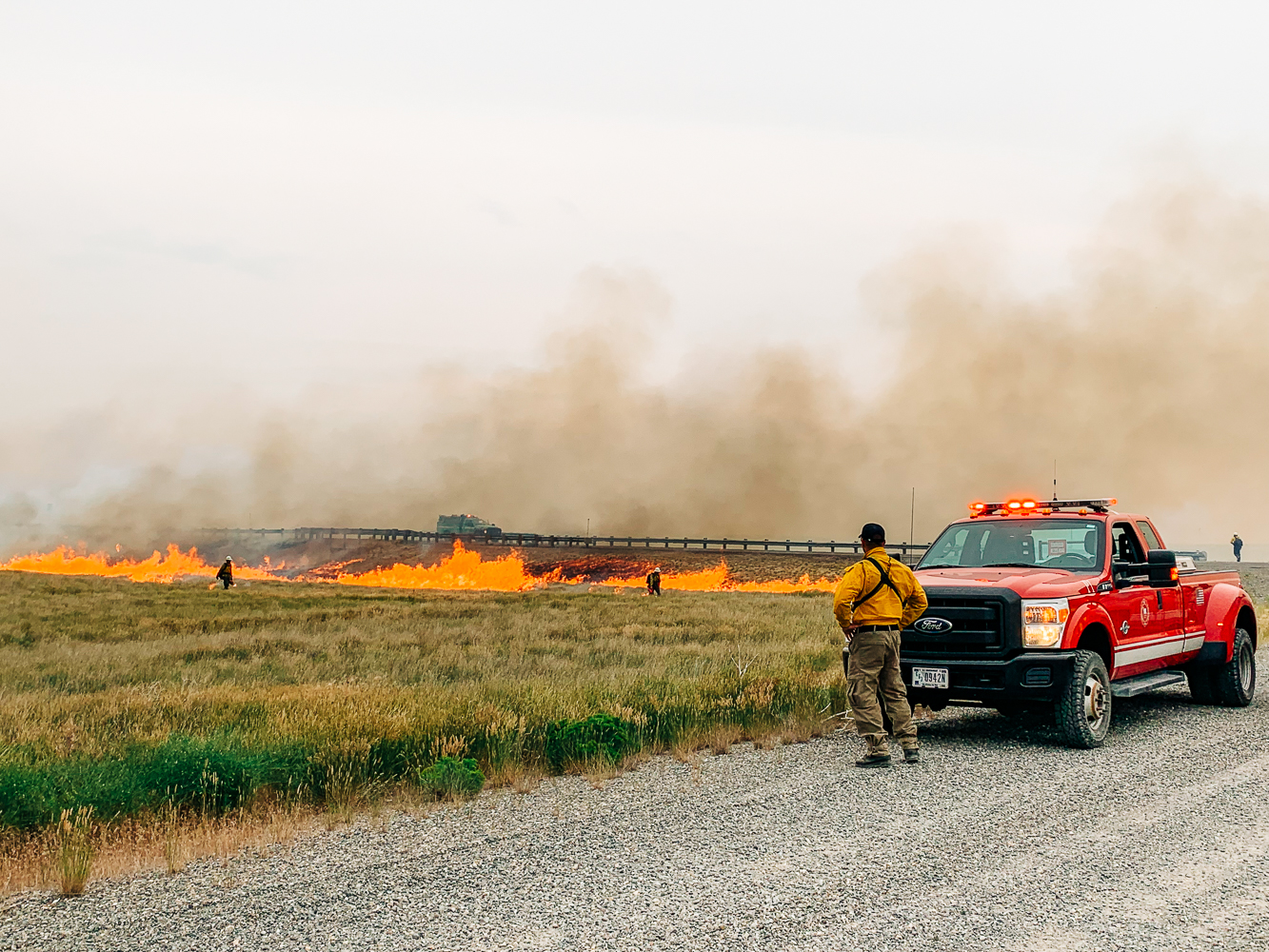With summer 2020 at hand, the Idaho National Laboratory Fire Department is preparing for all eventualities. Fire is a fact of life on the Snake River Plain, the land on which INL sits, and the memory of 2019’s Sheep Fire, the largest in the Site’s history, is fresh in everyone’s minds.

Before each summer fire season, the INL Fire Department reviews its preparation procedures and lessons learned from previous fires. “We manage our operation around the fire threat,” said INL Fire Chief Eric Gosswiller. Snowpack over the winter was near normal in eastern Idaho and western Wyoming, but conditions in other parts of Idaho are reverting to drought. “The big picture is that there is above normal large fire potential for most of the Great Basin,” Gosswiller said. “Temperatures are expected to be above normal, we don’t expect much rain, and we have an abundance of grasses that could make for a big fire season regionally.”
Reported on the afternoon of July 22, 2019, the Sheep Fire burned an estimated 112,106 acres of vegetation. Despite its size, however, damage to INL property was limited to signs, incidental storage at one location, and 12 INL power distribution poles. No buildings were affected and there were no reported injuries.
In the aftermath, INL, the U.S. Bureau of Land Management (BLM), the state of Idaho and other partners developed a post-fire recovery plan to address impacts of fire suppression activities. Fire containment lines constructed with bulldozers during the Sheep Fire were reseeded in May, with high-priority areas seeded with a native grass mix.

INL has a highly trained fire department with extensive wildland firefighting experience. Twenty-two firefighters are on duty at all times, and if additional responders are needed, the department can recall off-duty employees to bring its force up to 75. For big emergencies, INL has a reciprocal firefighting agreement with regional fire departments, as well as an agreement with the BLM. The agreements allow agencies to assist one another with an aggressive initial attack and provide essential support during extended fire emergencies.
As it has everywhere, the COVID-19 pandemic has forced changes and precautionary measures. Firefighters’ temperatures are routinely taken, and briefings and meetings have been done online as much as possible. Logistical planning this year has focused on prevention and initial attack – coming at any reported fire aggressively with the aim of getting it under control as soon as possible.
As always, education is an important part of the firefighting effort. While lightning – the cause of the Sheep Fire – can’t be avoided, all INL employees are kept informed about high fire potential and precautions they need to take. Off-road vehicles and off-road activity are restricted in times of elevated fire danger.
“Anything we can do to keep fires from happening is going to be especially important,” Gosswiller said.
INL is a U.S. Department of Energy (DOE) national laboratory that performs work in each of DOE’s strategic goal areas: energy, national security, science and environment. INL is the nation’s center for nuclear energy research and development. Day-to-day management and operation of the laboratory is the responsibility of Battelle Energy Alliance.
See more INL news at www.inl.gov. Follow us on social media: Twitter, Facebook, Instagram and LinkedIn.
—INL-20-023—
Additional Background Information:
- The INL Fire Department has three stations on the desert, each equipped with wildland firefighting equipment. The department maintains four heavy Type 4 wildland fire engines, one Type 6 engine and a 3,000-gallon tactical tender.
- INL’s electrical power loop is redundant, which means that during wildland fires power can be redirected and maintained. Major site facilities have emergency backup power supplies.
- Risks to radiological facilities and important buildings are protected by natural and constructed firebreaks, widespread use of noncombustible construction materials, and the presence of reliable water supplies and automatic fire suppression systems.
- The INL Emergency Operations Center in Idaho Falls and emergency control centers at each site facility maintain trained teams able to communicate in real time with firefighters.
Sheep Fire statistics:
- The Sheep Fire was reported on the afternoon of July 22, 2019.
- By July 26, 2019, it had burned an estimated 112,107 acres of vegetation, the largest fire in the Site’s 70-year history and the second largest in the lower 48 states in 2019.
- Over 120 firefighters from 15 agencies were involved in bringing the Sheep Fire under control with no injuries.
- No INL buildings were damaged and power was maintained to all facilities throughout the fire.
- The fire affected 21 soils types, nine vegetation classes, and numerous wildlife species, including greater sage grouse, designated as a Species of Greatest Conservation Need by the state of Idaho.
Lessons learned, unique facts from the 2019 Sheep Fire:
- None of the power poles on INL’s main transmission loop were lost during the fire. The protective coating INL uses proved very effective, a lesson shared with regional utilities throughout the West.
- Close to 75% of the land burned in the Sheep Fire had already burned at least once before, and some sections had burned four or five times.
- A comprehensive assessment of cultural resource impacts has been completed.
- Aerial imagery was obtained, and an ecological resource assessment completed. The process included enhanced collaboration with stakeholders. INL is executing informed Sheep Fire rehabilitation activities. 25,000 acres of aerial sagebrush reseeding was completed in February. Additional noxious weed treatment is planned this year. Additional monitoring and mitigating actions are planned next year.
- INL completed lessons learned training with all support personnel. The training emphasizes unified command successes from the Sheep Fire, communication plans, a formal staging area and check-in process, and a new dozer boss position to supervise fire line construction activities.





